
Asphalt cement used in the road construction industry is semi-solid at ambient temperatures.
Asphalt cement used in the road construction industry is semi-solid at ambient temperatures. It can be readily liquefied by heating, adding a petroleum solvent, or emulsifying it in water. In the production of hot mix asphalt, heat is used to liquefy the asphalt cement so it will coat the aggregate and remain workable during transport, mixing, laydown, and compaction. As the asphalt cement cools, it hardens and regains the binding properties that make it an effective paving material. When a petroleum solvent such as naphtha or kerosene is added to asphalt cement to make it fluid, the product is called a cutback asphalt. In the field, the cutback “cures” as the solvent evaporates, restoring the asphalt’s binding properties.
Asphalt cement can also be made liquid by dispersing it as microscopic droplets in water containing chemical surfactants (emulsifiers). Stable asphalt emulsions are produced by high shear mixing of the asphalt cement and emulsifier solution in a colloid mill. When emulsions are used in the field, the water evaporates leaving behind the asphalt residue. In addition to producing no or minimal hydrocarbon emissions, asphalt emulsions provide a versatile, cost-effective alternative to asphalt cement and cutback asphalts.
History of Asphalt Emulsion
Asphalt emulsions were first developed in the early 1900’s and came into general use in pavement applications in the 1920’s. Their early use was in spray applications and as dust palliatives. The growth in the use of asphalt emulsions was relatively slow, limited by the type of emulsions available and a lack of knowledge as to how they should be used. Continuing development of new types and grades, coupled with improved construction equipment and practices, now gives a broad range of choices. Virtually any roadway requirement can be met with emulsions. Judicious selection and use can yield significant economic and environmental benefits.
Advantages of Asphalt Emulsions
The advantages of Asphalt Emulsions are many and include ready availability as petroleum solvents become increasingly more costly and unavailable; energy savings as little or no heat required for transport, storage, mixing, and spraying; reduction in atmospheric pollution as there are minimal or no hydrocarbon emissions; safer jobsites due to the elimination of volatiles in the working environment; their ability to coat damp aggregate surfaces, thus reducing the fuel requirements for heating and drying aggregates; readily available custom design of emulsions allows for optimization of aggregate performance and construction system. Asphalt emulsions also allow the addition of performance enhancing additives such as stabilizers, coating improvers, anti-strip or break control agents and impart advantageous properties, such as High-Float to the asphalt cement.
Quality and Performance
Asphalt emulsions are designed and manufactured to meet specific job applications. Handling and performance characteristics can be adjusted by varying the type and amounts of ingredients used. Handling and setting characteristics are typically adjusted by selecting the appropriate type of emulsifier (surfactant) to produce slow-set (SS), medium-set (MS), and rapid-set (RS) emulsions. Final residual properties are dictated by the base asphalt used and the addition of any rheological modifiers and other additives (ex- High-Float modifier, polymers, and adhesion agents).
While strict quality control procedures are employed to ensure product consistency from batch to batch, performance properties can be adjusted to suit the available aggregates and/or construction conditions. It is always advisable to consult with the emulsion supplier to assist in the selection of the most appropriate emulsion grade with respect to a particular asphalt-aggregate combination.
Common Applications for Asphalt Emulsions
Tack Coat
A tack coat is a very light spray application of diluted asphalt emulsion. It creates a bond between the asphalt overlay being placed and the existing asphalt surface. It is recommended for all overlays.
Emulsion type: SS-1, MS-1.
Typical Application Rate: 0.2 – 0.4 litres/m2 (undiluted).
Prime Coat
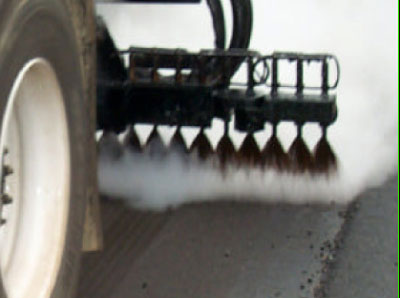 |
A prime coat is a spray application of low viscosity asphalt emulsion on granular base in preparation for placing a surface treatment. Its function is to waterproof and toughen the surface until the subsequent asphalt treatment (ex- hot mix, chip seal) is placed. In addition, it provides a bond between the base and the overlying layer.
Emulsion type: EAP-2.
Typical Application Rate: 0.8 – 1.0 litres/m2.
Dust Palliative
A dust palliative is a spray or blade mixed application of an asphalt emulsion to a granular surface. Its function is to coat and bind the aggregate, thus preventing it from becoming airborne.
Emulsion type: DL-10 (spray), DL-10 Special (blade mix).
Typical Application Rate: 1.0 – 2.0 litres/m2, 2.0 – 5.0 litres/m2.
Spray-Patching (Pothole Repair)
Spray injection machines apply an asphalt emulsion onto the sides and bottom of the pothole to tack the surface. The same emulsion is then spray injected onto the aggregate as the pothole is filled.
Emulsion type: WSPE-1, RS-1, CRS-2.
Typical Application Rate: 5% by weight of aggregate.
Crack Sealing
After being cleaned of debris, a viscous asphalt emulsion is poured into the crack.
Emulsion type: EC-101, CRF.
Typical Application Rate: 0.2 – 0.3 litres/linear meter.
Graded Aggregate Seal Coat
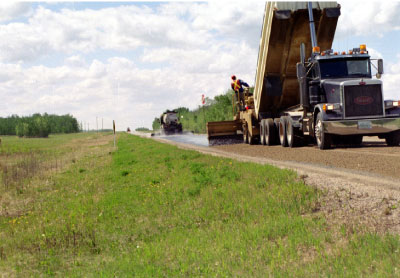
|
A graded aggregate seal coat is an application of asphalt emulsion followed with a covering of graded aggregate. The main purpose of such a seal is to provide a waterproof, wearing course. Graded aggregate seals can be applied to granular base or as a wearing surface on pavement. In addition to having the “High Float” property, these emulsions can be modified with polymers and adhesion agents to further improve performance.
Emulsion type: HF100S, HF150S, HF250S, HF350S, HF100P, HF150P, HF250P.
Typical Application Rate: 1.6 – 2.8 litres/m2 (rate depends mainly on aggregate top-size).
Chip Seal
A chip seal is similar to a graded aggregate seal except the asphalt emulsion application is followed with a covering of washed chips. Its function is to provide a new wearing surface and waterproofing membrane on pavements subject to higher traffic volumes. Chip seals (as well as graded aggregate seals) improve surface texture and increase the amount of light reflected. Polymers can be added to further improve performance.
Emulsion type: CRS-2, CRS-2P.
Typical Application Rate: 1.8 – 2.5 litres/ m2
Slurry Seal
Slurry seal is a mixture of asphalt emulsion, dense graded aggregate, mineral filler, and water. Mixed and applied with specialized equipment, slurry seals provide a new wearing surface to pavements. Setting and curing times depend on the type of emulsion used and weather conditions.
Emulsion type: SS-1, SS-1H, CSS-1, CSS-1H, CQS-1H.
Typical Application Rate: 14 – 21% by weight of aggregate.
Micro-Surfacing
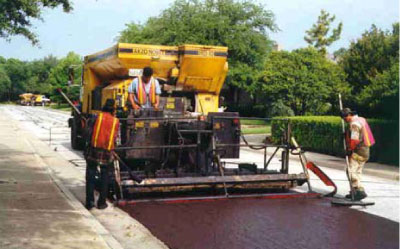
|
Micro-Surfacing is a mixture of quick setting polymer modified asphalt emulsion, well graded aggregate, mineral filler, and water. Specialized equipment produces and lays the mixture in one step. It provides a renewed surface that can be applied in thicknesses varying from the maximum aggregate size up to 40 mm (can be use to fill wheel ruts). Traffic can typically be permitted within one hour of laydown.
Emulsion type: CQS-1HP.
Typical Application Rate: 11 – 15% by weight of aggregate.
Preservative and Restorative Seals
The surface life of an existing asphalt pavement can be extended with the use of specialized emulsions. These emulsions are surface sprayed and penetrate into the pavement. Their function is to restore the beneficial properties of the aged asphalt cement in the pavement.
Emulsion type: CRF, Reclamite.
Typical Application Rate: 0.2 – 0.4 litres/m2 (undiluted basis).
Full Depth Reclamation
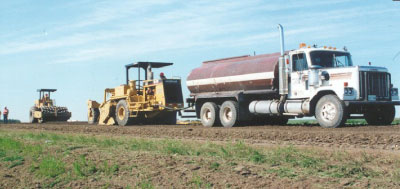
|
Full depth reclamation involves the incorporation of an asphalt emulsion with the existing asphalt mix, granular base and sometimes the sub-grade soil. Its function is to restore structural strength and provide an improved load carrying base for a new pavement.
Emulsion type: Various (commonly SS-1 or CSS-1).
Typical Application Rate: 1.0 – 2.0 % by weight of mix.
Cold In-Place Recycling
Severely distressed pavements on a structurally sound base can be cost-effectively restored by cold in-place recycling. A specialized recycling “train” of equipment is used to mill the existing asphalt layer, crush and screen materials, mix in emulsion, and finally lay down and compact the new mix all in one pass.
Emulsion type: Typically HF150S, HF150P, or CMS-2.
Typical Application Rate: 1.0 – 2.0 % by weight mix.
Recycling Reclaimed Asphalt Pavement
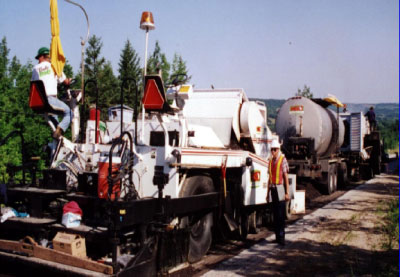 |
Reclaimed asphalt pavement (RAP) can be rejuvenated by adding an appropriate rejuvenating emulsion. This can be done in a plant, blade mixed on site, or surface sprayed after the RAP is laid out and compacted. A variety of asphalt emulsions can be used for recycling. Type and grade selection depends on the nature of the RAP, method of incorporation, and the desired final properties.
Emulsion type: Various (commonly Reclamite).
Typical Application Rate: 1.0 – 5.0% by weight of mix depending on nature of RAP.
Maintenance Mixtures
A maintenance mix is a blend of asphalt emulsion and aggregate used for pothole patching as well as blade-laid and paver-laid cold mix. It is typically prepared warm in an asphalt plant. The resulting mixture can be stored either short-term or long-term (over winter for early spring use) depending on the emulsion grade added.
Emulsion type: HF500M, HF1000M,
HF500M -HR.
Typical Application Rate: 6.0 – 7.5% by weight of aggregate, 5.0 – 5.5% for HF-500M-HR.
Road Mix
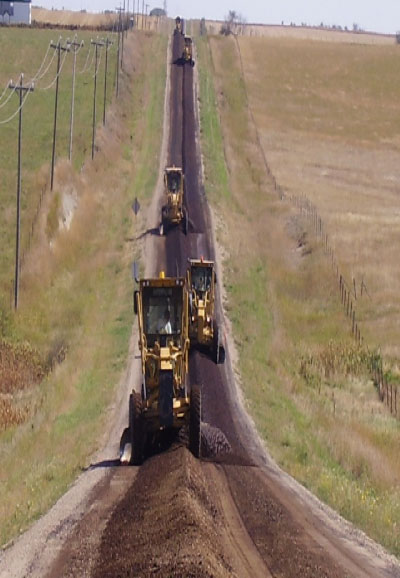
|
Emulsions can be added to a well-graded aggregate with a motor-grader on a roadway to produce a cold mix asphalt pavement. When High-Float emulsions are employed, the resulting pavement will typically have superior performance to other “road oil” or cutback asphalt mixtures.
Emulsion type: HF500M, HF1000M.
Typical Application Rate: 7.0 – 7.5% by weight of aggregate.
Warm Mix Asphalt
In an effort to reduce emissions from conventional hot mix asphalt mixtures, new technologies have been developed that significantly lower the working temperature required for the production and placement of these materials. Some of these new processes employ recently developed asphalt emulsions. In addition to lower temperatures and less energy consumption, the use of these emulsions allows the use of conventional plant mixing equipment.
Emulsion type: Various proprietary emulsions.
Typical Application Rate: 7.0 – 7.5% by weight of aggregate.
In addition to the above mentioned processes, there are a number of specialty construction techniques that employ a variety of specialized equipment and emulsions.
This article was submitted by Pounder Emulsions, part of The Husky Oil, Pounder Emulsions and Western Road Management group of companies. The group manufactures and markets both technologies throughout Western Canada and Northwestern USA.
Print this page